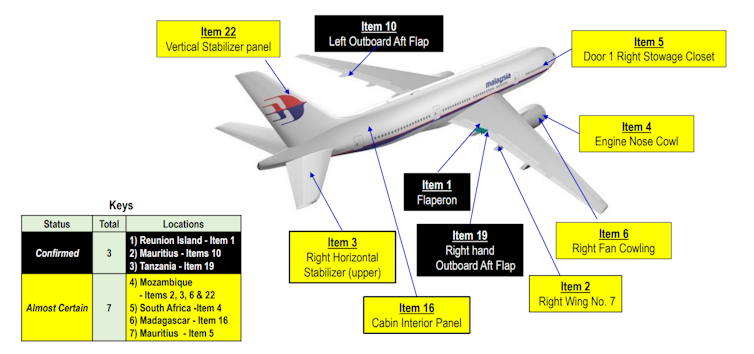Lessons to learn, despite another report on missing flight MH370 and still no explanation
- Written by Geoffrey Dell, Associate Professor/Discipline Leader Accident Investigation and Forensics, CQUniversity Australia
The latest report into the disappearance of Malaysia Airlines flight MH370 says that investigations have failed to find any explanation as to why the aircraft went missing with 239 passengers and crew on board.
The 449-page main report (with additional appendices) from the Malaysian government builds on previous reports on the investigation into the missing aircraft but admits it is “limited by a significant lack of evidence”.
Read the report: MH370 Safety Investigation Report - Ministry of Transport Malaysia
It’s been four years since the Boeing 777-200ER went missing from its routine flight between Malaysia’s capital Kuala Lumpur and China’s capital Beijing.
The aircraft was later found to have deviated from that flight path, with calculations showing that it probably disappeared somewhere in the Indian Ocean, off the Western Australian coast.
But despite an extensive search led by Australia, and later a private operator search, the report says no main wreckage or bodies of the 227 passengers and 12 crew on board have ever been found.
Some parts identified as confirmed or almost certain to have been from the missing aircraft have been recovered, washed up around the Indian Ocean.
 Confirmed and almost certain debris identification wreckage from MH370.
Ministry of Transport Malaysia
Confirmed and almost certain debris identification wreckage from MH370.
Ministry of Transport Malaysia
The aircraft itself has not been located, and neither the aircraft’s Flight Data Recorder (FDR) nor the Cockpit Voice Recorder (CVR) has been recovered. The only information available to the investigators was from other sources, making triangulation and validation of evidence difficult, if not impossible.
Read more: The search for MH370 is over: what we learnt and where to now
Who’s to blame?
The report notes that MH370 went missing on March 8, 2014, soon after a routine handover from the Malaysian to Vietnamese air traffic control. Communications with the aircraft were lost less than 40 minutes after takeoff.
Both Malaysian and Vietnamese air traffic controllers delayed initiation of emergency procedures once communication could not be established with the aircraft following the crossover from one air space to another. This, the report says, delayed any search-and-rescue response.
Given that the initial search area was north of the Malaysian Peninsula on the aircraft’s intended track, and any information suggesting the aircraft might have flown back over the peninsula didn’t emerge for some time, the initial delays in initiating the search-and-rescue phase may be moot.
The report covers several other issues related to the flight, aircraft maintenance, the crew, the cargo etc, but its conclusion ends with the line:
…the (Investigation) Team is unable to determine the real cause for the disappearance of MH370.
Still a mystery
Clearly, someone or something was responsible for the loss of the aircraft, passengers and crew. But without evidence from the flight recorders it’s unlikely that any of the many theories as to the cause will be proven.
The report suggests that from the available information and simulations, the aircraft was manually turned off the planned track, suggesting an intent on behalf of whoever was flying the aircraft. The turning off of the transponders that allow the aircraft to be tracked by civilian radars also suggests intent.
Hence the report goes to some lengths to suggest that unlawful interference with flight MH370 cannot be ruled out.
But extensive background checks of the captain and other crew found absolutely no evidence of anything other than a dedicated, professional team who set off to do their job as they had done many many times before.
So the causes of the tragedy are likely to remain conjecture for some considerable time, unless new evidence comes to light.
No closure for the families
Clearly the families of those who perished onboard MH370 will not gain much closure from this report. It contains very few answers for them.
 Family of those missing on MH370 are still looking for answers.
EPA/Fazry Ismai
Family of those missing on MH370 are still looking for answers.
EPA/Fazry Ismai
But it needs to be said that the air safety investigators need data from multiple sources to try to establish with a reasonable degree of certainty the causes of crashes.
Aviation is a very complex socio-technical system that requires reliable analytics to fully understand the system interactions and deviations. Yet without the recorded flight data and no access to the wreckage, the ability to find cause is critically hampered.
Lessons learned (and to learn)
Since the loss of MH370 there has been a global push to improve tracking of airline aircraft. Clearly the travelling public want air traffic control authorities to know where all the aircraft are all of the time, without fail and without the capacity for anyone to turn the tracking system off.
Many in aviation would like that ideal world too. But the current tracking systems don’t have that capacity. The amount of data that would entail is well beyond the capacity of the present systems, and the cost of upgrading the systems to cope with that would be exorbitant.
For example, the current satellite constellation would need to be expanded or significantly enhanced. So, there has to be a compromise.
 The Malaysian Safety Investigation Team released the report into the mystery of Malaysia Airlines flight MH370 disappearance.
EPA/Fazry Ismail
The Malaysian Safety Investigation Team released the report into the mystery of Malaysia Airlines flight MH370 disappearance.
EPA/Fazry Ismail
As the report suggests, it’s likely that improvements to the system will result in airborne aircraft “handshaking” with the tracking system every 15 minutes with GPS position, altitude, heading and speed data.
This should significantly improve the probability of finding an aircraft lost, but it will not guarantee a lost aircraft’s location will be known.
For example, if the aircraft is cruising at 350 knots (about 650kph) when it makes its last handshake with the tracking system, in 15 minutes it could be anywhere in a search area with around a 300km diameter, still representing a significant search conundrum.
Changes in emergency locator beacon capability are also arising from the MH370 experience. The problems with underwater signal acoustics will remain problematic. So design changes in future will likely see beacons that have the capability to detach and float to the surface if an aircraft crashes into water.
From the perspective of the families and from the basis of needing to understand the real lessons from MH370, ideally the search for the aircraft should continue.
But the real challenge is where to look. Without new data to inform a new search effort, the only thing really known is the aircraft is most likely in the Indian Ocean somewhere. That’s the message from the wreckage that has washed ashore.
Authors: Geoffrey Dell, Associate Professor/Discipline Leader Accident Investigation and Forensics, CQUniversity Australia





